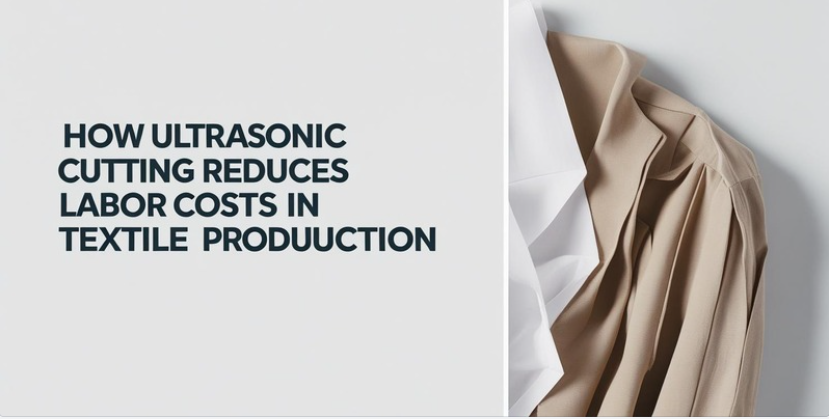Ultrasonic Seam Types: Butt Seams, Fold‑Over, Spot Bonds
- ztzgsteeltech
- Aug 5
- 4 min read

Ultrasonic sewing technology has rapidly transformed how synthetic fabrics, nonwovens, and thermoplastic materials are bonded together. Instead of needles, thread, or adhesives, ultrasonic sewing machines use high-frequency vibrations to create strong, clean, and consistent seams. These vibrations generate localized heat through friction, which melts and bonds the materials at the molecular level.
But not all ultrasonic seams are created the same. Depending on the application, fabric type, and end-use requirements, various seam types are used in ultrasonic sewing. Among the most common and effective are butt seams, fold over seams, and spot bonds.
This in-depth guide will break down each ultrasonic seam type, how it's formed, where it's used, and what advantages it offers.
What Makes Ultrasonic Seams Unique?
Unlike traditional stitched seams that puncture fabric and use thread, ultrasonic seams are fused joints. This makes them:
Strong and consistent
Free from pinholes or needle marks
Fray-resistant and sealed at the edges
Ideal for high-speed, automated production
Ultrasonic seams are especially valuable in industries like apparel, medical, automotive, hygiene, and packaging, anywhere that cleanliness, efficiency, and durability are priorities.
Let’s explore each seam type in detail.
Butt Seams: Simple, Strong, and Space-Efficient
What is a Butt Seam?
A butt seam joins two fabric edges edge-to-edge without any overlap. The fabrics are positioned next to each other, and ultrasonic energy is applied along the seam line, melting and bonding the materials where they meet.
Characteristics:
Flat and low-profile
No material overlap
Clean, continuous appearance
Often used in tube-shaped or cylindrical products
Advantages:
Space-saving seam design
Minimal material buildup at the joint
Maintains flexibility and softness
Common Applications:
Disposable garments
Air and liquid filters
Medical gowns and masks
Technical textiles for ventilation or filtration
Butt seams are ideal when fabric thickness needs to remain consistent, and when aesthetics or air-tight sealing is a priority.
Fold Over Seams: Reinforced and Decorative
What is a Fold Over Seam?
A fold over seam involves folding one or both fabric edges before bonding. The seam is then welded using ultrasonic vibrations, creating a reinforced joint with multiple layers of material at the seam.
Variations:
Single fold (one layer folded over and bonded to a flat layer)
Double fold (both layers folded and bonded)
Rolled or hemmed seam (edge is tucked and sealed)
Characteristics:
Visually prominent
Reinforced strength and durability
Adds structure to the finished product
Advantages:
High mechanical strength
Edge reinforcement and sealing
Decorative potential with embossing or tooling patterns
Common Applications:
Apparel trims and sleeves
Curtains and blinds
Quilted materials
Automotive interior linings
Fold over seams are often used when the seam needs to carry stress, act as a decorative border, or provide extra protection against fraying or tearing.
Spot Bonds: Minimalist and Multi-Point Attachment
What is a Spot Bond?
A spot bond uses ultrasonic energy to join fabrics at specific, isolated points instead of a continuous line. The bonding tool touches the material briefly at each point, creating a small, strong fused area.
Characteristics:
Small circular or square weld points
Discrete bonding areas
No continuous line or edge joining
Can be arranged in patterns
Advantages:
Extremely fast and energy-efficient
Allows air or liquid flow between bonded areas
Minimal fabric distortion
Lightweight bonding solution
Common Applications:
Surgical masks and protective garments
Filter pockets
Interfacing in apparel
Laminated nonwovens
Spot bonding is ideal for applications requiring flexibility, breathability, or precise control over bond locations.
Comparing Seam Types: Which to Use and When?
Seam Type | Fabric Contact | Strength Level | Aesthetic | Common Use |
Butt Seam | Edge-to-edge | Moderate | Flat, clean | Filters, garments |
Fold Over | Overlapping/folded | High | Prominent or decorative | Apparel, interior |
Spot Bond | Point contact | Low–Moderate | Subtle | Medical, hygiene, light-duty bonds |
Each seam type serves a distinct purpose. The choice depends on the product’s functional requirements, such as strength, appearance, flexibility, and cost, as well as the type of fabric or material being used.
Factors to Consider When Choosing a Seam Type
Material Compatibility: Not all fabrics respond equally. Thermoplastic content is key for effective ultrasonic bonding.
Application Stress: If the seam will experience tension or wear, a fold over seam may be more appropriate.
Breathability Needs: Spot bonding allows airflow, which is critical in filters or medical garments.
Edge Protection: Fold over seams offer the best edge protection against fraying.
Production Speed: Butt seams and spot bonds are faster to process and often used in high-volume manufacturing.
Understanding these factors helps manufacturers make informed decisions when designing products and selecting ultrasonic sewing machines and tooling.
Final Thoughts
Ultrasonic sewing machines offers a variety of seam options to meet diverse production needs. Whether you’re working with lightweight nonwovens, synthetic textiles, or composite materials, there is an ultrasonic seam type that will deliver both performance and aesthetics.
Choose butt seams for flat, compact seams with clean edges.
Opt for fold over seams when strength and style are important.
Use spot bonds for breathable, light-duty applications.
By mastering these ultrasonic seam types, manufacturers can elevate product quality, increase production efficiency, and unlock new design possibilities—without thread, needles, or adhesives.



Comments